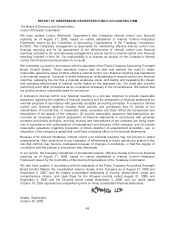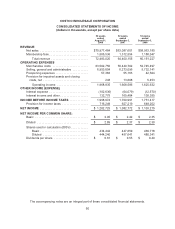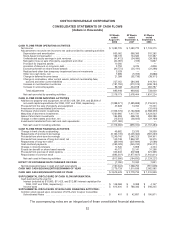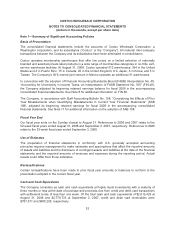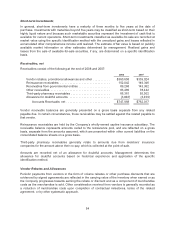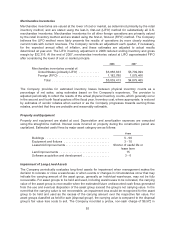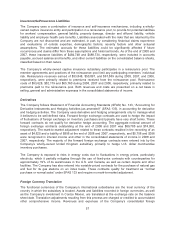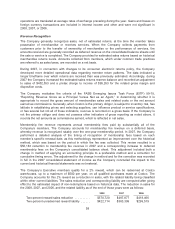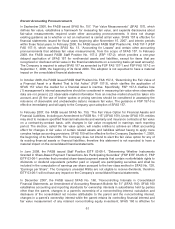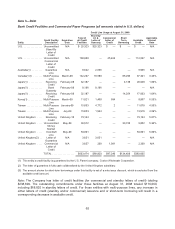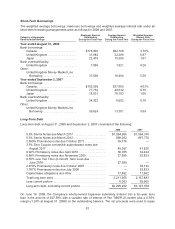Costco 2008 Annual Report Download - page 59
Download and view the complete annual report
Please find page 59 of the 2008 Costco annual report below. You can navigate through the pages in the report by either clicking on the pages listed below, or by using the keyword search tool below to find specific information within the annual report.Insurance/Self Insurance Liabilities
The Company uses a combination of insurance and self-insurance mechanisms, including a wholly-
owned captive insurance entity and participation in a reinsurance pool, to provide for potential liabilities
for workers’ compensation, general liability, property damage, director and officers’ liability, vehicle
liability and employee health care benefits. Liabilities associated with the risks that are retained by the
Company are not discounted and are estimated, in part, by considering historical claims experience
and evaluations of outside expertise, demographic factors, severity factors and other actuarial
assumptions. The estimated accruals for these liabilities could be significantly affected if future
occurrences and claims differ from these assumptions and historical trends. As of the end of 2008 and
2007, these insurance liabilities of $484,748 and $488,734, respectively, were included in accounts
payable, accrued salaries and benefits, and other current liabilities on the consolidated balance sheets,
classified based on their nature.
The Company’s wholly-owned captive insurance subsidiary participates in a reinsurance pool. The
member agreements and practices of the reinsurance pool limit any participating members’ individual
risk. Reinsurance revenues earned of $53,848, $50,897, and $67,589 during 2008, 2007, and 2006,
respectively, were primarily related to premiums received from the reinsurance pool. Reinsurance
costs of $53,628, $52,179 and $65,760 during 2008, 2007 and 2006, respectively, primarily related to
premiums paid to the reinsurance pool. Both revenues and costs are presented on a net basis in
selling, general and administrative expenses in the consolidated statements of income.
Derivatives
The Company follows Statement of Financial Accounting Standards (SFAS) No. 133, “Accounting for
Derivative Instruments and Hedging Activities (as amended)” (SFAS 133), in accounting for derivative
and hedging activities. The Company uses derivative and hedging arrangements only to manage what
it believes to be well-defined risks. Forward foreign exchange contracts are used to hedge the impact
of fluctuations of foreign exchange on inventory purchases and typically have very short terms. These
forward contracts do not qualify for derivative hedge accounting. The aggregate notional amount of
foreign exchange contracts outstanding at the end of 2008 and 2007 was $89,785 and $74,950,
respectively. The mark-to-market adjustment related to these contracts resulted in the recording of an
asset of $4,625 and a liability of $856 at the end of 2008 and 2007, respectively, and $5,758 and $358
were recognized in interest income and other in the consolidated statements of income in 2008 and
2007, respectively. The majority of the forward foreign exchange contracts were entered into by the
Company’s wholly-owned United Kingdom subsidiary primarily to hedge U.S. dollar merchandise
inventory purchases.
The Company is exposed to risks in energy costs due to fluctuations in energy prices, particularly
electricity, which it partially mitigates through the use of fixed-price contracts with counterparties for
approximately 19% of its warehouses in the U.S. and Canada, as well as certain depots and other
facilities. The Company has also entered into variable-priced contracts for the purchase of natural gas
and fuel for its gas stations on an index basis. These contracts qualify for treatment as “normal
purchase or normal sales” under SFAS 133 and require no mark-to-market adjustment.
Foreign Currency Translation
The functional currencies of the Company’s international subsidiaries are the local currency of the
country in which the subsidiary is located. Assets and liabilities recorded in foreign currencies, as well
as the Company’s investment in Costco Mexico, are translated at the exchange rate on the balance
sheet date. Translation adjustments resulting from this process are charged or credited to accumulated
other comprehensive income. Revenues and expenses of the Company’s consolidated foreign
57



